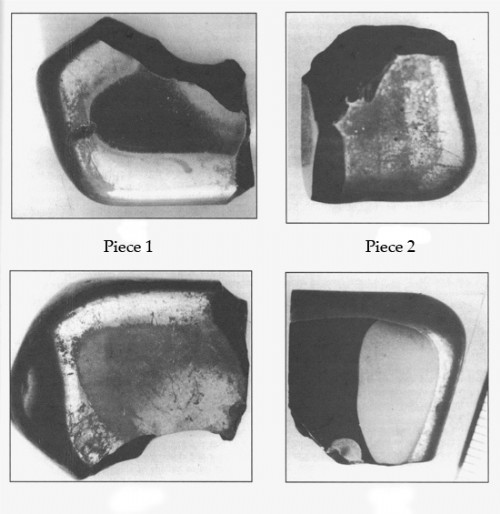UFO Case Report:
Metal artifact found after close encounter on Island of Vaddo, Sweden
Date: November 11, 1956
Location: Isle of Vaddo, Sweden
Stig Ekberg and Harry Sjoberg were driving on the Island of Vaddo, Sweden, when they were approached by a flattened sphere shaped object. It settled in the middle of the road, about 100 meters in front of them. After about ten minutes, the object lifted off and accelerated away. At the landing site, the witnesses found a shiny "rock" that was hot to the touch. It was a three-sided piece of metal about the size of a matchbox, and had a heavy weight. Upon analysis, the object was found to be composed of tungsten carbide and cobalt.

Two pieces of the artifact (the two left images are piece #1, and on the right is piece #2). (credit: Illobrand Von Ludwiger)
Classification & Features
Type of Case/Report: StandardCase
Hynek Classification: CE2
# of Witnesses: Multiple
Special Features/Characteristics: Artifact, Vehicle Interference, Smell/Odor, Physical Trace
More Articles on this Case
Metal Artifact And UFO Sighting, Isle of Vaddo, Sweden
Illobrand von Ludwiger (excerpts reprinted by Mark Cashman)
Main report on the metal artifact from the Isle of Vaddo, Sweden (excerpts).
Full Report / Article
Source: Jacques Vallee, in Peter Sturrock, 'The UFO Enigma'
[This fragment sample] was recovered by two witnesses of an aerial phenomenon. Although the material appears to be common tungsten carbide, the original shape of the specimen was unusual and it has not been identified as an object serving a conventional use.
According to a summary of the case compiled by Von Ludwiger (1998), the two witnesses, Stig Ekberg and Harry Sjoberg, were building a house on the island of Vaddo, about 90 kilometers north-northwest of Stockholm. At about 10 p.m., Ekberg was driving his Ford V8 pickup when they saw a bright flying object with the shape of a flattened sphere 8 meters wide and 3 meters high approaching from the right (from the east) against the clear night sky. They estimated that it flew about 1 kilometer in front of them at an altitude of 100 meters. Suddenly it made a sharp turn toward them, at which time the truck engine sputtered and died and the headlights went out. The object started "slowly gliding down." It seemed to rock back and forth until it came to a stop in the middle of the road, about 100 meters in front of them, 1 meter above the ground. "It was illuminating the surrounding landscape with such a tremendous amount of light that even a barn, half a kilometer away, was visible as if the sun was shining." The air smelled like ozone and smoldering insulation.
After about ten minutes the light of the object intensified, it lifted off the ground, moved to the left and up, made a sudden turn, and accelerated away in the direction from which it came. At that point Ekberg was able to restart the truck normally, and the headlights came back on. Observing that the grass at the landing site had been flattened, they investigated further and found a shiny "rock" that was hot to the touch. It was a three-sided piece of metal about the size of a matchbox, and had a heavy weight.
After several unsuccessful attempts to have the sample studied, it was taken to the SAAB airline manufacturing company, where Mr. Sven Schalin conducted a thorough analysis. Other tests were later run in laboratories in Sweden, Denmark, and Germany. The general conclusion was that the object was composed of tungsten carbide and cobalt, consistent with manufactured products. According to Von Ludwiger, "All industrial countries have companies which produce such hard metals, and the manufacturing technology is in principle the same. . . . The overall quality of the material was outstanding, but not unusual for the early 1950s."
Case ID: 837
edit: 837
FAIR
USE NOTICE: This page may contain copyrighted material the
use of which has not been specifically authorized by the
copyright owner. This website distributes this material without
profit to those who have expressed a prior interest in receiving
the included information for scientific, research and educational
purposes. We believe this constitutes a fair use of any such
copyrighted material as provided for in 17 U.S.C § 107.





